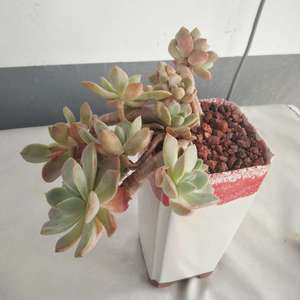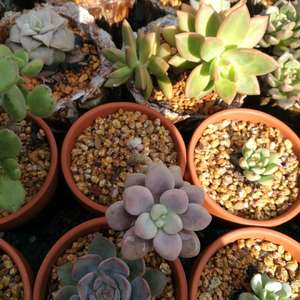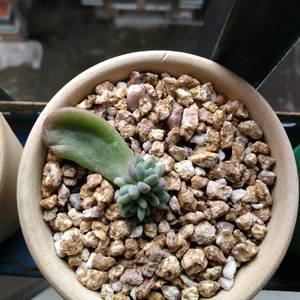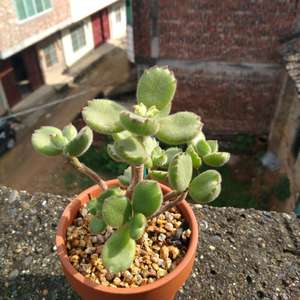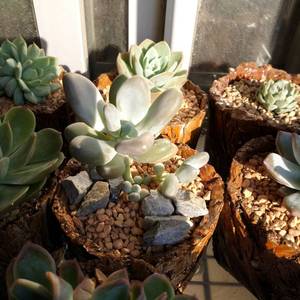文章
Miss Chen
2018年06月04日

Description: This herbaceous perennial plant is about 1-2' tall. In mature plants, the central stem divides into 2 or 3 side stems, while immature plants usually remain undivided. The upper portion of each plant tends to nod downward because of the weight of the leaves and flowers. The terete stems are glabrous and glaucous; they are light green or pale reddish green. The alternate leaves are up to 6" long and 2" across. They are oblong-ovate to elliptic, smooth along their margins, and parallel-veined. The base of each leaf is perfoliate – it completely surrounds the stem. The upper surface of each leaf is pale green to green and glabrous, while the lower surface is white to greenish white and finely short-pubescent (canescent). In mature plants, each side stem terminates with a single flower that has an elongated bell-like shape.
The flowers are about 1-2" long and they hang downward from slender pedicels about 1" long. The pedicels are similar to the stems, except they are more slender. Each flower consists of 6 pale yellow to yellow tepals, 6 stamens, and a pistil with a tripartite style. The slender tepals are slightly twisted and greenish toward the base of the flower, while their interior surface is smooth and hairless. The yellow anthers of the stamens are large and elongated, but they remain mostly hidden by the tepals. The blooming period occurs during the mid-spring and lasts about 2 weeks. The flowers are slightly fragrant. Each flower is replaced by a 3-celled seed capsule that is obovoid in shape with 3 rounded lobes and a rounded tip; each cell of this capsule contains several seeds. The root system is rhizomatous, from which vegetative offsets are often produced. This plant occasionally forms colonies.

Cultivation: The preference is dappled sunlight during the spring and light shade during the summer. The soil should be moderately moist and loamy with a layer of decaying leaves. It is best to locate this plant underneath a deciduous tree that does not cast heavy shade during the summer. It is easier to start new plants from divisions, rather than by seeds.
Range & Habitat: The native Large-Flowered Bellwort occurs occasionally in most areas of Illinois, except for a few counties in southern part of the state (see Distribution Map). Populations of this wildflower have declined somewhat because of deer-browsing, habitat destruction, invasion of various non-native shrubs, and invasion of Garlic Mustard (Alliaria petiolata). Habitats include mesic deciduous woodlands, wooded slopes, large river banks in wooded areas, and edges of shady seeps. The presence of this plant in a deciduous woodlands is an indication that much of the original ground flora is still intact.

Faunal Associations: Bumblebees, mason bees (Osmia spp.), Halictid bees (Halictus spp., Lasioglossum spp.), and Andrenid bees (Andrena spp.) suck nectar or collect pollen from the flowers. The seeds are distributed by ants because of their attached elaiosomes (small food bodies). The foliage is heavily grazed by deer; this species declines in abundance when there is an overpopulation of deer in wooded areas. The foliage is probably vulnerable to other mammalian herbivores as well.
Photographic Location: A deciduous woodland along a river bank at Allerton Park in Piatt County, Illinois.

Comments: The flowers are rather shy and often hide behind the leaves. The foliage of Large-Flowered Bellwort (Uvularia grandiflora) is attractive and resembles the foliage of Polygonatum commutatum (Smooth Solomon's Seal). However, the leaves of the latter species are sessile or clasping, while the leaves of Large-Flowered Bellwort are perfoliate. The only other species in this genus that occurs in Illinois (the southern part only) is Uvularia sessilifolia (Sessile-Leaved Bellwort). As the name suggests, the leaves of this species are sessile, rather than perfoliate, and its flowers are a little smaller than those of Large-Flowered Bellwort. The 3-celled seed capsules of this species are sharply lobed (even winged), while the corresponding lobes of Large-Flowered Bellwort are well-rounded. Another species in this genus, Uvularia perfoliata (Perfoliate Bellwort), occurs in areas to the east of Illinois. This species has perfoliate leaves like Large-Flowered Bellwort. However, its seed capsules are truncated at their tips and its tepals have glandular hairs on the interior surface. Large-Flowered Bellwort has seed capsules with rounded tips and its tepals are smooth on the interior surface.
The flowers are about 1-2" long and they hang downward from slender pedicels about 1" long. The pedicels are similar to the stems, except they are more slender. Each flower consists of 6 pale yellow to yellow tepals, 6 stamens, and a pistil with a tripartite style. The slender tepals are slightly twisted and greenish toward the base of the flower, while their interior surface is smooth and hairless. The yellow anthers of the stamens are large and elongated, but they remain mostly hidden by the tepals. The blooming period occurs during the mid-spring and lasts about 2 weeks. The flowers are slightly fragrant. Each flower is replaced by a 3-celled seed capsule that is obovoid in shape with 3 rounded lobes and a rounded tip; each cell of this capsule contains several seeds. The root system is rhizomatous, from which vegetative offsets are often produced. This plant occasionally forms colonies.

Cultivation: The preference is dappled sunlight during the spring and light shade during the summer. The soil should be moderately moist and loamy with a layer of decaying leaves. It is best to locate this plant underneath a deciduous tree that does not cast heavy shade during the summer. It is easier to start new plants from divisions, rather than by seeds.
Range & Habitat: The native Large-Flowered Bellwort occurs occasionally in most areas of Illinois, except for a few counties in southern part of the state (see Distribution Map). Populations of this wildflower have declined somewhat because of deer-browsing, habitat destruction, invasion of various non-native shrubs, and invasion of Garlic Mustard (Alliaria petiolata). Habitats include mesic deciduous woodlands, wooded slopes, large river banks in wooded areas, and edges of shady seeps. The presence of this plant in a deciduous woodlands is an indication that much of the original ground flora is still intact.

Faunal Associations: Bumblebees, mason bees (Osmia spp.), Halictid bees (Halictus spp., Lasioglossum spp.), and Andrenid bees (Andrena spp.) suck nectar or collect pollen from the flowers. The seeds are distributed by ants because of their attached elaiosomes (small food bodies). The foliage is heavily grazed by deer; this species declines in abundance when there is an overpopulation of deer in wooded areas. The foliage is probably vulnerable to other mammalian herbivores as well.
Photographic Location: A deciduous woodland along a river bank at Allerton Park in Piatt County, Illinois.

Comments: The flowers are rather shy and often hide behind the leaves. The foliage of Large-Flowered Bellwort (Uvularia grandiflora) is attractive and resembles the foliage of Polygonatum commutatum (Smooth Solomon's Seal). However, the leaves of the latter species are sessile or clasping, while the leaves of Large-Flowered Bellwort are perfoliate. The only other species in this genus that occurs in Illinois (the southern part only) is Uvularia sessilifolia (Sessile-Leaved Bellwort). As the name suggests, the leaves of this species are sessile, rather than perfoliate, and its flowers are a little smaller than those of Large-Flowered Bellwort. The 3-celled seed capsules of this species are sharply lobed (even winged), while the corresponding lobes of Large-Flowered Bellwort are well-rounded. Another species in this genus, Uvularia perfoliata (Perfoliate Bellwort), occurs in areas to the east of Illinois. This species has perfoliate leaves like Large-Flowered Bellwort. However, its seed capsules are truncated at their tips and its tepals have glandular hairs on the interior surface. Large-Flowered Bellwort has seed capsules with rounded tips and its tepals are smooth on the interior surface.
0
0
文章
Miss Chen
2018年06月04日

Description: This perennial wildflower is 2–3½' tall and unbranched. The central stem is light green, terete, and pubescent. Pairs of opposite leaves occur at intervals along this stem; each pair of leaves rotates 90º from the orientation of the preceding pair of leaves. The leaves are up to 8" long and 4" across, ovate or ovate-oblong in shape, and smooth to slightly undulate along their margins. All or most leaves have winged bases that surround the stem and merge with the bases of the leaves on the opposite side. The upper surfaces of the leaves are dull green and hairless to slightly pubescent, while their lower surfaces are whitish green and covered with short fine pubescence. Sessile clusters of 1-5 flowers occur in the axils of the leaves. Each flower has a narrow tubular corolla (about ½" long); usually this corolla is reddish brown (less often, it is more green or yellow). The corolla has 5 lobes that are short and well-rounded. The 5 sepals are about the same length as the corolla and linear in shape; they are light green to dark reddish brown. At the base of each flower, there is a 3-celled ovary that is green and hairy, and a pair of linear stipules that resemble the sepals. Within the corolla, there are 5 stamens and a single style with a knobby green stigma.
The blooming period occurs from late spring to mid-summer and lasts about a month. Each flower is replaced by a dry drupe about 1/3" (8 mm.) across that is globoid in shape and becomes orange at maturity. Inside each drupe, there are 3 black nutlets; these nutlets are 3-angled and oblongoid in shape. The root system consists of a taproot. This wildflower spreads by reseeding itself.
Cultivation: The preference is light shade to dappled sunlight, mesic to slightly dry conditions, and a loamy or rocky soil with abundant organic matter.
Range & Habitat: Late Horse Gentian is occasional in central and northern Illinois, becoming uncommon or absent in southern areas of the state (see Distribution Map). This is a native wildflower. Habitats include upland deciduous woodlands, rocky wooded slopes, thinly wooded bluffs, oak savannas, and limestone glades.

Faunal Associations: The nectar of the flowers attracts long-tongued bees, especially bumblebees (Bombus spp.) and Anthophorid bees (Anthophora spp.). Smaller short-tongued bees may visit the flowers, but they are less effective at cross-pollination. The caterpillars of the moth Hemaris diffinis (Snowberry Clearwing) feed on Triosteum spp. (Horse Gentians) and other members of the Honeysuckle family. Sometimes White-Tailed Deer chomp off the upper half of the central stem and its leaves.
Photographic Location: An upland oak woodland in McLean County, Illinois.
Comments: Late Horse Gentian is easily distinguished from other species of Horse Gentian (Triosteum spp.) by its stem-surrounding opposite leaves (they are connate-perfoliate). Other species in this genus have opposite leaves that taper to narrow bases that are little wider than the central stem. Except for this difference in their leaves, Late Horse Gentian is very similar in appearance to Early Horse Gentian (Triosteum aurantiacum) and they prefer similar habitats. Another species, Triosteum angustifolium (Yellow-Flowered Horse Gentian), has yellow flowers and more narrow leaves; its state distribution is restricted to southern Illinois.
The blooming period occurs from late spring to mid-summer and lasts about a month. Each flower is replaced by a dry drupe about 1/3" (8 mm.) across that is globoid in shape and becomes orange at maturity. Inside each drupe, there are 3 black nutlets; these nutlets are 3-angled and oblongoid in shape. The root system consists of a taproot. This wildflower spreads by reseeding itself.
Cultivation: The preference is light shade to dappled sunlight, mesic to slightly dry conditions, and a loamy or rocky soil with abundant organic matter.
Range & Habitat: Late Horse Gentian is occasional in central and northern Illinois, becoming uncommon or absent in southern areas of the state (see Distribution Map). This is a native wildflower. Habitats include upland deciduous woodlands, rocky wooded slopes, thinly wooded bluffs, oak savannas, and limestone glades.

Faunal Associations: The nectar of the flowers attracts long-tongued bees, especially bumblebees (Bombus spp.) and Anthophorid bees (Anthophora spp.). Smaller short-tongued bees may visit the flowers, but they are less effective at cross-pollination. The caterpillars of the moth Hemaris diffinis (Snowberry Clearwing) feed on Triosteum spp. (Horse Gentians) and other members of the Honeysuckle family. Sometimes White-Tailed Deer chomp off the upper half of the central stem and its leaves.
Photographic Location: An upland oak woodland in McLean County, Illinois.
Comments: Late Horse Gentian is easily distinguished from other species of Horse Gentian (Triosteum spp.) by its stem-surrounding opposite leaves (they are connate-perfoliate). Other species in this genus have opposite leaves that taper to narrow bases that are little wider than the central stem. Except for this difference in their leaves, Late Horse Gentian is very similar in appearance to Early Horse Gentian (Triosteum aurantiacum) and they prefer similar habitats. Another species, Triosteum angustifolium (Yellow-Flowered Horse Gentian), has yellow flowers and more narrow leaves; its state distribution is restricted to southern Illinois.
0
0
文章
Miss Chen
2018年06月04日

Description: This perennial wildflower is 2-4' tall and unbranched. The central stem is light green, terete, and covered with spreading white hairs that are non-glandular. Pairs of opposite leaves occur at intervals along this stem; each pair of leaves rotates 90º from the orientation of the preceding pair of leaves. Each leaf is up to 8" long and 3½" across, narrowly ovate to ovate in shape, and smooth along its margins, tapering to a narrow sessile base. The upper surface of each leaf is dull green to dull reddish green, while its lower surface is whitish green and covered with short fine pubescence. Flowers occur individually in the axils of the leaves. Each flower has a narrow tubular corolla that is reddish brown and about ½-¾" long. The corolla has 5 lobes that are short and well-rounded. The 5 sepals are about the same length as the corolla and linear in shape; they are green to dark reddish brown. At the base of the flower, there is a 3-celled ovary that is green and hairy; there is also a pair bracts that resemble the sepals, except they are smaller in size. The style is about the same length or slightly exerted from the corolla; it has a knobby green stigma. The 5 stamens are hidden with the corolla.
The blooming period occurs from late spring to early summer and lasts about 1-2 months. Each flower is replaced by a dry drupe about ½" long that is globoid-ovoid in shape and becomes orange or orange-red at maturity. Inside each drupe, there are 3 black nutlets that are 3-angled and oblongoid in shape. The root system consists of a taproot. This wildflower spreads by reseeding itself.
Cultivation: The preference is light shade to dappled sunlight, mesic to slightly dry conditions, and a loamy or rocky soil with abundant organic matter.
Range & Habitat: Illinois Horse Gentian is occasional in most areas of the state (see Distribution Map), where it is native. Habitats include upland deciduous woodlands, rocky wooded slopes, and thinly wooded bluffs. Rarely is this species found in prairies.
Faunal Associations: The nectar of the flowers attracts long-tongued bees, especially bumblebees (Bombus spp.) and Anthophorid bees (Anthophora spp.). Smaller short-tongued bees may visit the flowers, but they are less effective at cross-pollination. The caterpillars of the moth Hemaris diffinis (Snowberry Clearwing) feed on Triosteum spp. (Horse Gentians) and other members of the Honeysuckle family.

Photographic Location: A wooded slope near Charleston, Illinois.
Comments: In spite of the common name, this wildflower is not a gentian (a member of the Gentianaceae); it is more closely related to the honeysuckles. Illinois Horse Gentian differs from the typical variety of Triosteum aurantiacum by the long non-glandular hairs along its stem; the typical variety has some glandular hairs along its stem that are often shorter. Some taxonomic botanists in Illinois consider Illinois Horse Gentian to be a separate species, Triosteum illinoense; however, this reclassification hasn't gained much acceptance from taxonomic botanists outside of the state. Another similar species, Triosteum perfoliatum (Perfoliate Horse Gentian), has opposite leaves that are joined together at the base and surround the stem; the opposite leaves of Illinois Horse Gentian are sessile and remain distinct.
The blooming period occurs from late spring to early summer and lasts about 1-2 months. Each flower is replaced by a dry drupe about ½" long that is globoid-ovoid in shape and becomes orange or orange-red at maturity. Inside each drupe, there are 3 black nutlets that are 3-angled and oblongoid in shape. The root system consists of a taproot. This wildflower spreads by reseeding itself.
Cultivation: The preference is light shade to dappled sunlight, mesic to slightly dry conditions, and a loamy or rocky soil with abundant organic matter.
Range & Habitat: Illinois Horse Gentian is occasional in most areas of the state (see Distribution Map), where it is native. Habitats include upland deciduous woodlands, rocky wooded slopes, and thinly wooded bluffs. Rarely is this species found in prairies.
Faunal Associations: The nectar of the flowers attracts long-tongued bees, especially bumblebees (Bombus spp.) and Anthophorid bees (Anthophora spp.). Smaller short-tongued bees may visit the flowers, but they are less effective at cross-pollination. The caterpillars of the moth Hemaris diffinis (Snowberry Clearwing) feed on Triosteum spp. (Horse Gentians) and other members of the Honeysuckle family.

Photographic Location: A wooded slope near Charleston, Illinois.
Comments: In spite of the common name, this wildflower is not a gentian (a member of the Gentianaceae); it is more closely related to the honeysuckles. Illinois Horse Gentian differs from the typical variety of Triosteum aurantiacum by the long non-glandular hairs along its stem; the typical variety has some glandular hairs along its stem that are often shorter. Some taxonomic botanists in Illinois consider Illinois Horse Gentian to be a separate species, Triosteum illinoense; however, this reclassification hasn't gained much acceptance from taxonomic botanists outside of the state. Another similar species, Triosteum perfoliatum (Perfoliate Horse Gentian), has opposite leaves that are joined together at the base and surround the stem; the opposite leaves of Illinois Horse Gentian are sessile and remain distinct.
0
0








